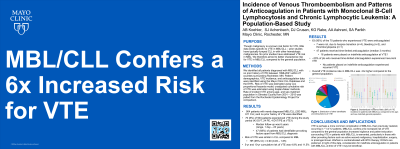Back

Clinical Posters
JL1018C: Incidence of Venous Thromboembolism and Patterns of Anticoagulation in Patients with Monoclonal B-Cell Lymphocytosis and Chronic Lymphocytic Leukemia: A Population-Based Study
Saturday, October 22, 2022
10:00 AM – 11:00 AM ET


Amber Koehler, MPAS, PA-C
Physician Assistant, Assistant Professor of Medicine
Mayo Clinic
Rochester, Minnesota, United States
Poster Presenter(s)
PURPOSE
Though malignancy is a known risk factor for VTE, little data exists specific to VTE in MBL/CLL; prior studies have often lumped MBL/CLL in with other hematologic malignancies. We aimed to better characterize the risk of VTE specific to MBL/CLL.
METHODS
We identified individuals with newly diagnosed MBL/CLL between 1998-2021 within 27 counties surrounding Rochester, MN. Patient demographics, VTE incidence, and anticoagulation data were identified using the Mayo Clinic CLL Database and electronic health record. Risk of VTE was estimated using Cox proportional hazards model; unadjusted cumulative risk of VTE was estimated using Kaplan-Meier methods. Rate of incident VTE among age- and sex-matched population in Olmsted County, MN from 2001-2015 was pulled from the Rochester Epidemiology Project, and compared to patients with MBL/CLL.
RESULTS
We identified 946 patients with newly diagnosed MBL/CLL; 42 were excluded due to prior history of VTE. Of 904 remaining subjects, 293 had MBL and 611 had CLL. Median age was 69 years (range, 28-96 years) and 587 (65%) were male. After median follow-up of 6 years (range, 1 day-23years), 70 patients developed VTE (43 DVT; 24 PE, 4 DVT/PE)). Risk of VTE was similar in CLL compared to MBL [HR(95% CI)=0.90(0.49-1.65)]. The 5-year and 10-year cumulative risk of VTE was 4.9% and 11.5%. Forty-seven (68%) patients had provoking factors including second active malignancy (n=21), surgery (n=9), hospitalization (n=6), travel (n=4), trauma (n=3), line-associated VTE (n=3), and immobility (n=1). Age-adjusted VTE incidence rates for females and males with newly diagnosed MBL/CLL were 1275 and 1228 per 100,000 person-years, compared to 193 and 218 per 100,000 person-years in the general population. Overall VTE incidence rate in females and males after MBL/CLL diagnosis was 6.0 (95% CI:4.0-8.8) and 5.7 (95% CI:4.1-7.7) higher than the general population.
Sixty-three patients received anticoagulation; 7 did not due to hospice transition (n=4), bleeding (n=2), and thrombocytopenia (n=1). Regimens included warfarin (n=32), apixaban (n=12), rivaroxaban (n=9), low molecular weight heparin (n=8), and unfractionated heparin (n=2). Forty-seven patients received time-limited anticoagulation at first VTE (median duration 3 months), 10 of whom experienced recurrent VTE. None of the sixteen patients placed on indefinite anticoagulation at first VTE experienced recurrence within the study period.
CONCLUSIONS
In this large population-based cohort study, 1 in 12 patients with MBL/CLL developed VTE after median follow-up of 6 yrs. Patients with MBL/CLL demonstrated a 6-fold increased risk of VTE compared to age- and sex-matched general population. Over 2/3 of MBL/CLL patients had provoking factors at time of VTE, especially second active malignancy. No patients placed on indefinite anticoagulation at first VTE experienced recurrence, but ~20% of patients who received time-limited anticoagulation experienced recurrent VTE.
IMPLICATIONS
Clinicians should be aware of increased risk for VTE in patients with MBL/CLL, prompting increased vigilance and patient education surrounding VTE in this population, particularly those with active second malignancy, hospitalization, surgery, or prolonged travel. Importantly, warfarin is contraindicated with BTK inhibitors and direct oral anticoagulants are preferred; dose modifications of BTK inhibitors and/or DOACs may be necessary due to concomitant risk of bleeding.
Though malignancy is a known risk factor for VTE, little data exists specific to VTE in MBL/CLL; prior studies have often lumped MBL/CLL in with other hematologic malignancies. We aimed to better characterize the risk of VTE specific to MBL/CLL.
METHODS
We identified individuals with newly diagnosed MBL/CLL between 1998-2021 within 27 counties surrounding Rochester, MN. Patient demographics, VTE incidence, and anticoagulation data were identified using the Mayo Clinic CLL Database and electronic health record. Risk of VTE was estimated using Cox proportional hazards model; unadjusted cumulative risk of VTE was estimated using Kaplan-Meier methods. Rate of incident VTE among age- and sex-matched population in Olmsted County, MN from 2001-2015 was pulled from the Rochester Epidemiology Project, and compared to patients with MBL/CLL.
RESULTS
We identified 946 patients with newly diagnosed MBL/CLL; 42 were excluded due to prior history of VTE. Of 904 remaining subjects, 293 had MBL and 611 had CLL. Median age was 69 years (range, 28-96 years) and 587 (65%) were male. After median follow-up of 6 years (range, 1 day-23years), 70 patients developed VTE (43 DVT; 24 PE, 4 DVT/PE)). Risk of VTE was similar in CLL compared to MBL [HR(95% CI)=0.90(0.49-1.65)]. The 5-year and 10-year cumulative risk of VTE was 4.9% and 11.5%. Forty-seven (68%) patients had provoking factors including second active malignancy (n=21), surgery (n=9), hospitalization (n=6), travel (n=4), trauma (n=3), line-associated VTE (n=3), and immobility (n=1). Age-adjusted VTE incidence rates for females and males with newly diagnosed MBL/CLL were 1275 and 1228 per 100,000 person-years, compared to 193 and 218 per 100,000 person-years in the general population. Overall VTE incidence rate in females and males after MBL/CLL diagnosis was 6.0 (95% CI:4.0-8.8) and 5.7 (95% CI:4.1-7.7) higher than the general population.
Sixty-three patients received anticoagulation; 7 did not due to hospice transition (n=4), bleeding (n=2), and thrombocytopenia (n=1). Regimens included warfarin (n=32), apixaban (n=12), rivaroxaban (n=9), low molecular weight heparin (n=8), and unfractionated heparin (n=2). Forty-seven patients received time-limited anticoagulation at first VTE (median duration 3 months), 10 of whom experienced recurrent VTE. None of the sixteen patients placed on indefinite anticoagulation at first VTE experienced recurrence within the study period.
CONCLUSIONS
In this large population-based cohort study, 1 in 12 patients with MBL/CLL developed VTE after median follow-up of 6 yrs. Patients with MBL/CLL demonstrated a 6-fold increased risk of VTE compared to age- and sex-matched general population. Over 2/3 of MBL/CLL patients had provoking factors at time of VTE, especially second active malignancy. No patients placed on indefinite anticoagulation at first VTE experienced recurrence, but ~20% of patients who received time-limited anticoagulation experienced recurrent VTE.
IMPLICATIONS
Clinicians should be aware of increased risk for VTE in patients with MBL/CLL, prompting increased vigilance and patient education surrounding VTE in this population, particularly those with active second malignancy, hospitalization, surgery, or prolonged travel. Importantly, warfarin is contraindicated with BTK inhibitors and direct oral anticoagulants are preferred; dose modifications of BTK inhibitors and/or DOACs may be necessary due to concomitant risk of bleeding.

